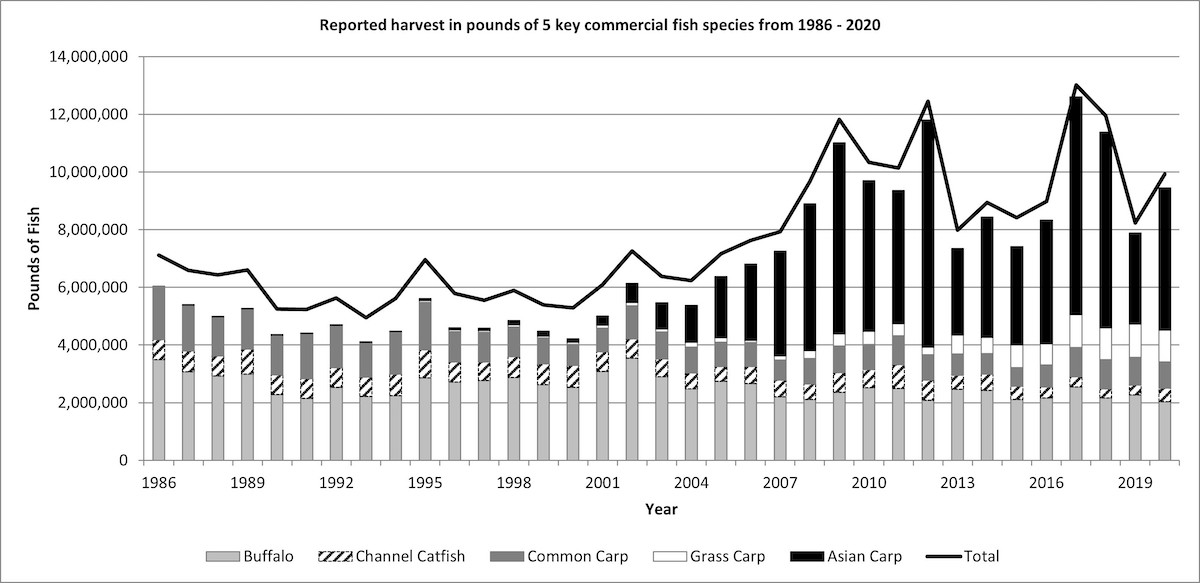Photo by Kevin Irons.


Illinois Commercial Fishing Trends


Commercial fishermen are like farmers of the river, both are built on hard and often dangerous work and require long hours regardless of weather conditions to provide food for not only their families, but also families throughout the United States.
Commercial fishing has historically been family oriented and a way of life, with knowledge, skills and equipment passed on through generations. The number of commercial fishing licenses sold in Illinois has decreased more than 50 percent in the last 40 years and full-time commercial fishermen are becoming a thing of the past. There seems to be some generational differences. In 1950, there were 229 full time commercial fishermen. By 1985, Illinois had only 70 full time commercial fishermen; by 2020 only 30 full time commercial fishermen existed. While the number of fishermen has declined, the pounds of fish harvested hasn’t, largely due to the shift to improved equipment, bigger boats and the addition of Asian carp harvest. Increased demand due to branding of Copi for human consumption has contributed.
Much like family farms, local fish markets run by commercial fishing families are now giving way to larger operations in which larger boats possessing faster motors that can cover larger areas, all to maximize volume of fish harvested to make a profit.

Just like in farming, the cost of equipment, fuel, and harvesting continues to rise, but the average wholesale price of fish per pound has remained stable since 1980. Throughout the years, a few groups of fish—namely carp, buffalo and catfish—have accounted for the majority of harvest. While harvest of native fish, such as buffalo and channel catfish, has remained stable, carp harvest has increased and shifted from common carp to invasive Asian carp. Asian carp generally refer to four species of carp from Asia—bighead carp, silver carp, grass carp and black carp. When processed as human food these fish can be found as Copi in markets throughout the Midwest, By 2007, Asian carp became the most harvested fish within Illinois rivers. Commercial fishing has become one of the most effective tools in slowing the spread of Asian carp, utilized by several Midwest states to help moderate the abundance of this invasive species.
Official reports of annual harvest have consistently been submitted to the Illinois Department of Natural Resources (IDNR) since 1950, allowing the IDNR to determine how the fisheries in our commercial waters are doing. This data allows IDNR to protect Illinois resources for both commercial and recreational fishermen. A study within the Mississippi River Basin found that commercial harvest has not negatively influenced fish populations or recreational fishing and that this cooperative management has resulted in consistently productive fisheries throughout the Mississippi River Basin over time. Commercial fishermen have historically been a major part in providing the data for management and conservation, through cooperation and fishing reports. Recently IDNR has been working with the fishermen to ensure harvest of invasive species and looking at trends throughout the river fisheries.
The IDNR realizes the importance of the harvest information received from commercial fishermen and would like to increase our interaction with fishermen to continue gaining the data needed to ensure the fisheries resources of our rivers will continue to provide opportunities for all.

Sara Tripp recently accepted the Commercial Fishing Biologist position with the Illinois Department of Natural Resources (IDNR) in the summer of 2021. She graduated from Southern Illinois University and received her Master’s degree in 2007. Prior to joining the IDNR, Tripp worked on large Midwestern rivers in Indiana, Kentucky and Missouri, with a focus on commercial harvest and research on commercial species. Her hobbies include hunting and fishing. She is working with commercial fishermen in Illinois to continue a positive relationship with the IDNR and investigate to some current topics among states regarding trophy catfish and paddlefish.
Submit a question for the author
Question: I am looking to stock my 3 acre carp lake with 10,000 – 20,000 lbs. of carp. Do you know any commercial fishermen that I could buy directly from and pickup.
Thank you
Question: Where can I get a list of commercial fishermen that sell their fish?
Subscribe to our Newsletter
Explore Our Family of Websites
Similar Reads
Autumn on the Line: Fall Fishing Traditions in Illinois
November 3, 2025 by Steven Beltran
Now that School is in Session the Fishing Season is Over…NOT!
November 3, 2025 by Steven Beltran
Responding to an Insidious Invader: Tackling a hydrilla outbreak
November 3, 2025 by Claire Snyder
Using Long-term Data to Improve Sportfish Monitoring in Illinois Rivers
November 3, 2025 by Robert Mooney, Michael Spear, Brian Ickes, Andrya L. Whitten Harris, Jason A. DeBoer, David Glover, James T. Lamer
Caught on Camera
November 3, 2025 by Sheryl DeVore
The Bowfin: Illinois’ Living Fossil
November 3, 2025 by Gretchen Steele
Lighting a Spark for Nature – Hooked by a First Fish
November 3, 2025 by Michael Kamp
Return of the Giants: The reintroduction of alligator gar to the Cache River
November 3, 2025 by Mark Denzer, Rob Hilsabeck
The Sport Fish Restoration Act Has Been Supporting Fisheries Management for 75 Years: Part 2
November 3, 2025 by Vic Santucci
The Sport Fish Restoration Act Has Been Supporting Fisheries Management for 75 Years: Part 1
November 3, 2025 by Vic Santucci